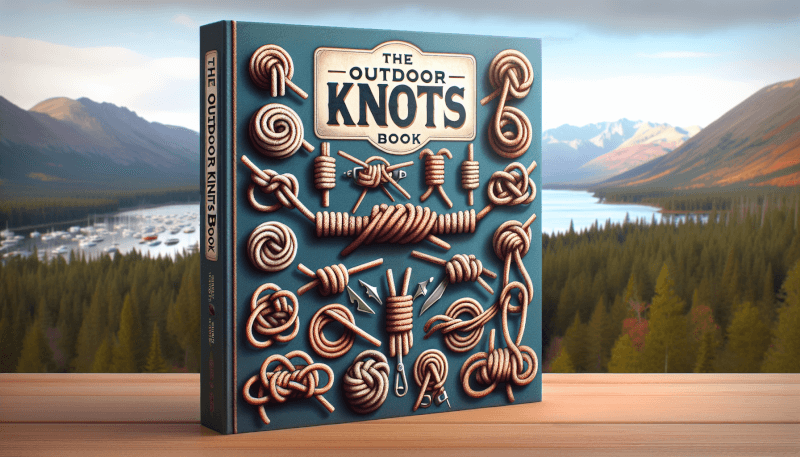Are you an outdoor enthusiast looking to enhance your knot-tying skills? Look no further than “The Outdoor Knots Book.” With easy-to-follow instructions and clear illustrations, this book is your ultimate guide to mastering various knots for outdoor activities. Whether you enjoy camping, hiking, or boating, this comprehensive guide will equip you with the knowledge and skills to securely tie essential knots that are vital for survival and safety in the great outdoors. Get ready to level up your knot-tying game and embark on your next adventure with confidence.
Chapter 1: Introduction to Knots

Understanding the Importance of Knots
Knots are an essential part of our lives, especially when it comes to outdoor activities and adventures. Whether you are camping, climbing, fishing, or even crafting, knowing how to tie the right knots can make a world of difference. Knots serve various purposes, including securing equipment, creating shelters, supporting weight, and ensuring safety while participating in outdoor activities.
Think of knots as your reliable companions in the wilderness. They provide stability, strength, and security. Without them, you would be left struggling to maintain control and accomplish tasks efficiently. Understanding the importance of knots is the first step towards becoming a skilled outdoors enthusiast. So, let’s dive into the world of knots and explore the possibilities they offer.
Basic Knot Terminology
Before we delve into the specific knots, it’s essential to familiarize ourselves with some basic knot terminology. Knowing the proper names and functions of various elements will make it easier for you to understand and learn new knots. Here are a few essential terms:
Bight: The curved section of a rope between the standing part and the working end.
Loop: A simple bend in the rope, forming an open circle.
Working end: The active part of the rope that you use to tie the knot.
Standing part: The stationary part of the rope that you hold onto while tying the knot.
Bight knot: A knot tied in the bight of a rope, formed by folding the rope back onto itself.
Hitch: A knot that attaches a rope to another object, such as a pole or a ring.
Running knot: A knot that slides along the rope when tension is applied.
Stopper knot: A knot tied at the end of a rope to prevent it from unraveling.
Binding knot: A knot used to secure or bind objects together.
Now that we have a basic understanding of knot terminology, let’s move on to exploring the knots specific to various outdoor activities.
Chapter 2: Essential Knots for Outdoor Activities
Clove Hitch Knot
The Clove Hitch knot is an essential knot for any outdoor enthusiast. It is relatively easy to tie and untie, making it perfect for securing objects such as tarps, tents, or poles. The knot consists of two overhand knots wrapped around an object. This knot is reliable and allows for easy adjustment.
Square Knot
The Square Knot, also known as the Reef Knot, is one of the most basic and widely used knots. It is simple to tie and untie, making it ideal for joining two ropes of equal thickness. However, it is important to note that the Square Knot is not suitable for heavy loads or critical applications, as it can slip or come undone under such conditions.
Bowline Knot
The Bowline Knot is often considered the king of knots due to its versatility and strength. It forms a secure loop at the end of a rope that doesn’t slip or bind. This knot is particularly useful in outdoor activities such as climbing, boating, and camping. It is easy to tie, untie, and adjust, making it a favorite amongst outdoor enthusiasts.
Sheet Bend Knot
The Sheet Bend Knot is perfect for joining two ropes of unequal thickness or different materials. It is a secure and reliable method of connecting ropes, commonly used in camping, boating, or when constructing shelters. The Sheet Bend Knot is easy to tie and untie, even after being under tension.

Figure 8 Knot
The Figure 8 Knot is a versatile and essential knot for many outdoor activities, especially climbing and mountaineering. It creates a strong and stable loop at the end of a rope that doesn’t slip or bind. The Figure 8 Knot is easy to tie and provides a secure connection between ropes, making it perfect for tying into a harness or securing equipment.
With these essential knots under your belt, you are well-equipped to engage in a variety of outdoor activities with confidence. However, there are specific knots that come in handy when it comes to shelter and camping.
Chapter 3: Knots for Shelter and Camping
Taut-Line Hitch Knot
The Taut-Line Hitch Knot is an adjustable knot perfect for securing tent guy-lines or clotheslines. Its ability to slide and grip allows you to tighten or loosen the tension as needed. This knot is invaluable for campers, as it ensures your tent stays taut even in changing weather conditions.
Trucker’s Hitch Knot
The Trucker’s Hitch Knot is the ultimate knot for securing heavy loads or creating a taut line. It provides significant mechanical advantage, allowing you to tighten the rope without much effort. This knot is commonly used for securing gear to vehicles, creating a clothesline, or setting up tarps for shelter in camping situations.
Prusik Knot
The Prusik Knot is an essential knot used during climbing, mountaineering, or when setting up a tarp. It creates a sliding loop that can be easily adjusted along the rope. This knot is primarily used for ascending or descending a rope, self-rescue, or for attaching additional gear to an existing rope.
Gutterman Knot
The Gutterman Knot is a lesser-known knot but serves as a useful alternative to the taut-line hitch. It is particularly handy when securing tents or tarps and is easy to tie and untie. The Gutterman Knot provides a reliable grip and holds tension well, making it a practical choice for campers and outdoor enthusiasts.
Now that we have covered knots for shelter and camping, let’s explore the knots essential for climbing and mountaineering.
Chapter 4: Knots for Climbing and Mountaineering
Double Fisherman’s Knot
The Double Fisherman’s Knot, often called the Grapevine Knot, is a highly secure knot used for joining two ropes of similar diameter. It is commonly used in climbing and mountaineering to create loops or anchors. This knot has exceptional strength, resists jamming, and does not compromise the integrity of the rope.

Water Knot
The Water Knot, also known as the Ring Bend, is a simple and reliable knot used to join two ends of webbing or flat rope. Climbers often use this knot to create slings or daisy chains. The Water Knot is easy to tie and untie, making it an integral part of any climber’s skill set.
Munter Hitch
The Munter Hitch, or Italian Hitch, is a versatile knot used by climbers for belaying or rappelling. It is easy to tie and untie, especially when compared to other more complex belay devices. The Munter Hitch provides friction control and can be used with various rope diameters, making it an essential knot for climbers.
Figure 8 Follow Through
The Figure 8 Follow Through is a critical knot used in climbing for attaching the rope to harnesses. It creates a secure and stable connection, ensuring the climber’s safety. This knot is simple to tie and inspect, making it a favorite amongst climbers and mountaineers.
Now that we have explored the knots essential for climbing and mountaineering, let’s move on to the knots used in fishing and boating.
Chapter 5: Knots for Fishing and Boating
Arbor Knot
The Arbor Knot is a popular and simple knot used for tying fishing line to a reel. It provides a strong and secure connection, ensuring that the line stays securely attached during casting and reeling in fish. The Arbor Knot is easy to tie and does not slip, making it a must-know knot for any angler.
Palomar Knot
The Palomar Knot is one of the strongest fishing knots used to tie hooks, lures, and snaps to fishing lines. It is easy to tie and provides exceptional strength and reliability. Anglers rely on the Palomar Knot for its simplicity and ability to withstand the stress of reeling in big catches.
Blood Knot
The Blood Knot is a popular knot used in fishing to join two lines of similar diameter. It is frequently used for attaching leaders or creating dropper loops. The Blood Knot is strong, reliable, and retains the majority of the lines’ original strength. Anglers appreciate this knot for its durability and simplicity.

Anchor Hitch
The Anchor Hitch is a secure and reliable knot used to attach a rope to an anchor or buoy. It is commonly used by boaters who need to secure their vessel to a fixed object. The Anchor Hitch grips well and does not slip or come undone under tension, providing peace of mind for boaters and sailors.
Now that we have covered knots for fishing and boating, let’s explore the decorative knots used in crafts and hobbies.
Chapter 6: Decorative Knots for Crafts and Hobbies
Monkey’s Fist Knot
The Monkey’s Fist Knot, with its distinctive bunched appearance, is a decorative knot that can be utilized in various crafts and hobbies. It is often used as a decorative element in jewelry, keychains, or home decor items. The Monkey’s Fist Knot is versatile and visually appealing, making it a favorite for craft enthusiasts.
Turk’s Head Knot
The Turk’s Head Knot is a decorative knot that resembles a woven band or ring. It is commonly used as a decorative element in woodworking, leatherwork, or as a braid on ropes or handles. The Turk’s Head Knot can be customized to different sizes and patterns, allowing for creative personalization in various craft projects.
Celtic Knot
The Celtic Knot is a decorative knot found in traditional Celtic art and design. It represents the interconnectedness of life and eternity. The Celtic Knot has intricate and beautiful patterns, making it a favorite for artwork, tattoos, or jewelry. This knot offers a touch of ancient charm and symbolism to any craft or hobby project.
Chinese Clover Knot
The Chinese Clover Knot, also known as the Lucky Knot, is a decorative knot widely used in Chinese culture for its symbolic significance. It is often seen in Chinese knots, accessories, and various handicrafts. The Chinese Clover Knot is visually appealing and can be used to represent luck, unity, or prosperity in different creative endeavors.
Now that we have explored decorative knots for crafts and hobbies, let’s move on to knots essential for survival and emergency situations.
Chapter 7: Knots for Survival and Emergency Situations
Quick Release Knot
The Quick Release Knot, also known as the Lark’s Head Variation, is a knot that can be easily untied under tension. It is essential in emergency situations where quick release of a knot is necessary. The Quick Release Knot provides a secure grip, usable strength, and ensures your safety in unpredictable circumstances.

Trilene Knot
The Trilene Knot is a highly reliable and popular knot used for tying fishing lines to hooks, lures, or swivels. Its strength and dependability make it an excellent choice for anglers in survival situations. The Trilene Knot is easy to tie, retains a high percentage of line strength, and resists slippage, ensuring your fishing line stays securely attached.
Prusik Loop Knot
The Prusik Loop Knot, similar to the Prusik Knot, is a valuable knot for climbers, mountaineers, and survivalists. It can be used for ascending or descending ropes in self-rescue situations, hauling gear, or creating emergency shelters. The Prusik Loop Knot provides reliable grip and adjustability, offering versatility and safety in critical moments.
Alpine Butterfly Knot
The Alpine Butterfly Knot, often called the Lineman’s Loop, is a versatile knot used in various survival and climbing scenarios. It creates a secure loop in the middle of a rope, ideal for attaching carabiners, slings, or creating a secure anchor point. The Alpine Butterfly Knot is easy to tie and untie, even after being loaded, making it an indispensable knot in emergency situations.
Now that we have explored knots for survival and emergency situations, let’s move on to Chapter 8, where we will discuss rope care and maintenance.
Chapter 8: Rope Care and Maintenance
Cleaning and Drying
Proper care and maintenance of your ropes are essential to ensure their longevity and reliability. Regularly clean your ropes by soaking them in a mild detergent solution and gently scrubbing them with a soft brush. Avoid high-pressure water or harsh chemicals. After cleaning, ensure the ropes are thoroughly dried in a well-ventilated area, away from direct sunlight or excessive heat.
Proper Storage
Storing your ropes correctly is crucial to prevent damage and maintain their integrity. Avoid storing ropes in damp or humid areas as this can lead to mold or mildew growth. Coil your ropes neatly, securing them with Velcro straps or rope bags. Hang them in a cool, dry place, away from direct sunlight or chemicals. Regularly inspect your storage area for any signs of moisture or pests.
Inspecting for Damage
Regularly inspecting your ropes for signs of wear or damage is vital for your safety. Look for frayed or worn areas, cuts, burns, or excessive dirt buildup. Check the integrity of knots, splices, or whipped ends. If any damage is detected, either repair the rope if possible or retire it if the damage is significant. Never compromise on safety when it comes to rope condition.
Proper rope care and maintenance will ensure your ropes remain in optimal condition and provide the reliability and safety you need during your outdoor adventures. Now, let’s move on to Chapter 9, where we will share some helpful tips and tricks for mastering knots.
Chapter 9: Tips and Tricks for Mastering Knots
Practice and Repetition
The key to mastering knots is consistent practice and repetition. Set aside regular time to practice tying various knots, starting with the basics and gradually progressing to more complex knots. Take your time, focusing on each step, until you can tie the knot confidently without referring to instructions. Practice in different scenarios, replicating real-life situations you may encounter outdoors.
Using Visual Aids
Visual aids such as diagrams, videos, or knot-tying apps can greatly enhance your learning experience. Utilize these resources to understand the knot structure, hand movements, and proper techniques. Visual aids help reinforce your understanding and make it easier to visualize each step. Combine visual learning with hands-on practice for optimal skill development.
Joining a Knotting Community
Joining a knotting community, whether in person or online, can provide you with valuable insights, tips, and guidance on knot tying. Participate in workshops, seminars, or forums where you can learn from experienced knot enthusiasts. Engaging with like-minded individuals will not only enhance your skills but also create a supportive network that fosters continuous learning and improvement.
By incorporating these tips and tricks into your knot-tying journey, you will gradually become proficient in the art of knot tying. Now, let’s move on to Chapter 10, where we will address frequently asked questions related to knots.
Chapter 10: Frequently Asked Questions
How Do I Choose the Right Knot for a Specific Task?
Choosing the right knot for a specific task involves considering various factors such as the application, load-bearing requirements, materials, and your level of skill. Evaluate the purpose and desired outcome of the knot, research the recommended knots for that particular task, and practice tying and testing them before using them in real-life situations. As you gain experience, you will develop a better understanding of which knots are best suited for specific tasks.
What Kind of Rope is Best for Outdoor Activities?
The choice of rope for outdoor activities depends on the specific application and environmental conditions you anticipate. Consider factors such as strength, durability, flexibility, and resistance to UV rays, moisture, and abrasion. Nylon ropes are known for their strength and versatility, while polypropylene ropes are lightweight and resistant to water. Some outdoor activities may require specialized ropes, such as static ropes for climbing or floating ropes for boating. Consult experts or reputable sources to determine the most suitable rope for your chosen activity.
Can Knots Come Undone?
While knots are designed to be secure and reliable, they can come undone under certain circumstances. Factors such as rope material, tension, constant movement, or external forces can contribute to knot failure. It is essential to regularly inspect and maintain your knots, ensuring they remain secure and show no signs of slippage or damage. Additionally, choosing the right knot for the task at hand and properly tightening and securing the knot will minimize the risk of it coming undone.
In conclusion, knots play a vital role in various outdoor activities, whether for safety, security, or functionality. By understanding the importance of knots, learning the essential knots for each activity, exploring decorative knots, and practicing proper rope care and maintenance, you will become a proficient knot enthusiast. Remember to always prioritize safety, follow proper techniques, and continue learning and improving your knot-tying skills.


